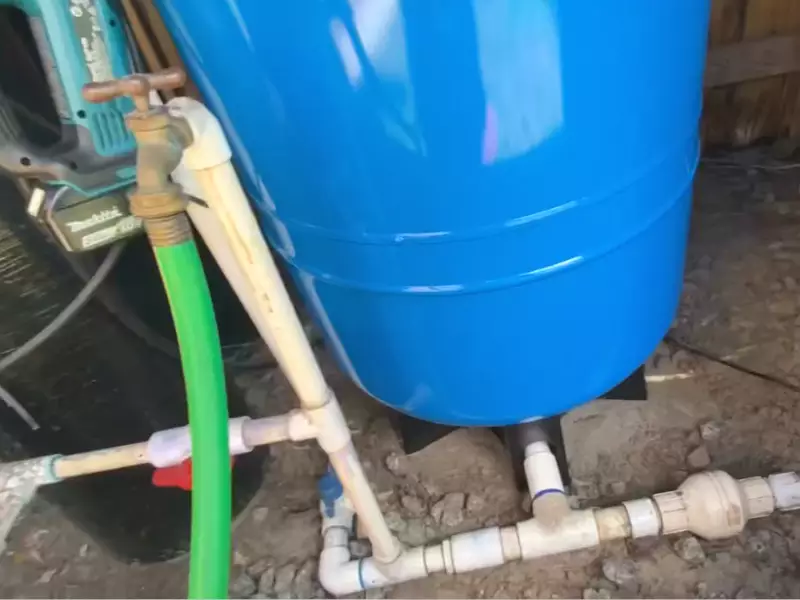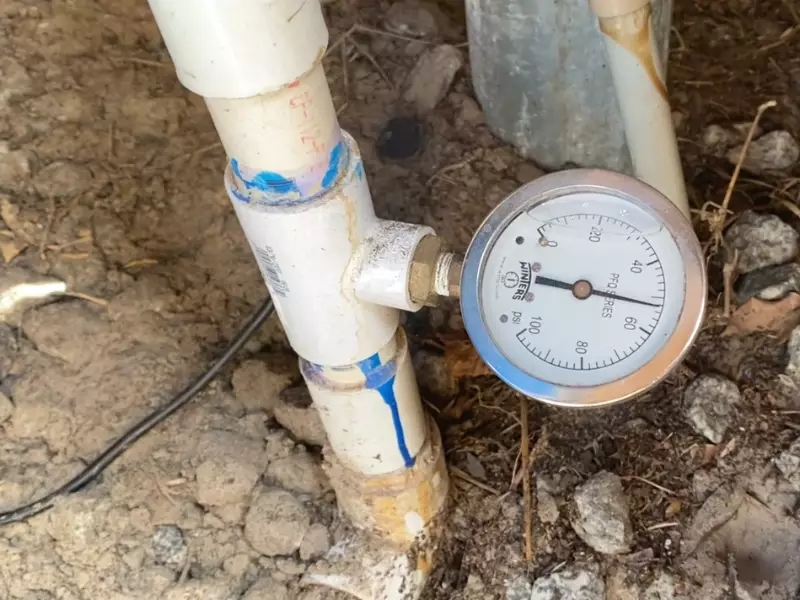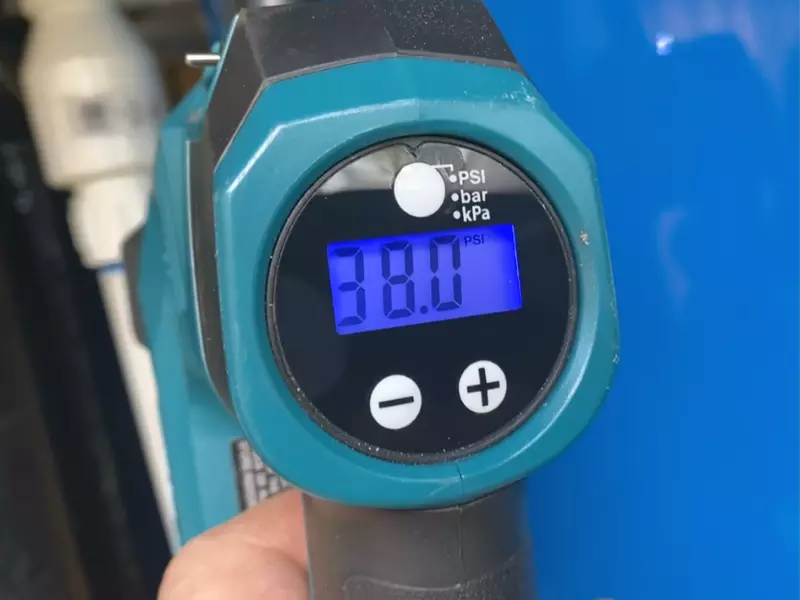Well water tanks are crucial components of private water supply systems. These tanks ensure that households have a steady supply of water, drawn from a private well, whenever they open a faucet. A significant factor influencing the functionality of such tanks is the air pressure inside them.
The optimal air pressure for a well water tank largely depends on its type and the pump’s capacity, but generally, it should be 2 psi below the pump’s cut-in pressure. This balance ensures the system functions efficiently and prolongs the lifespan of the pump.

Basics of a Well Water Tank
Well water tanks play a pivotal role in ensuring consistent water supply to households. Their primary function is to store water and ensure a steady water flow, minimizing the number of times the pump has to start and stop.
What is a Well Water Tank?
A well water tank is essentially a storage system. When the pump draws water from the well, it stores in this tank. This mechanism ensures that the water is readily available when needed, reducing the constant operation of the pump.
Purpose and Functionality
The tank serves as a buffer, storing water and releasing it under pressure when a tap is turned on. This mechanism reduces strain on the pump and conserves energy.
Air Pressure: Why It Matters
Maintaining the right air pressure in a well water tank isn’t just a matter of ticking off a maintenance checklist; it’s pivotal for various reasons, from the efficiency of water delivery to the operational lifespan of the equipment involved.
Role in Water Delivery
The balance of air and water inside your tank directly influences the efficiency and consistency of your water supply.
- Consistent Water Flow: Proper air pressure ensures that water is delivered at a steady rate, preventing instances of sputtering taps or inconsistent streams. Too low pressure might cause water to dribble out, while too high can result in forceful and unpredictable spurts.
- Avoidance of Air Locks: Correct air pressure mitigates the chances of air locks in the system. Air locks can disrupt the flow of water and require tedious manual intervention to rectify.
- Enhanced User Experience: Whether it’s for drinking, showering, or watering plants, a consistent water flow without any hiccups significantly enhances user experience.
Impact on Water Pump Longevity
Your water pump is a core component of the entire system, and its health and operational longevity are intimately tied to air pressure.
- Prevention of Rapid Cycling: When the pressure is too low, the pump tends to turn on and off too frequently, a phenomenon known as rapid cycling. This constant on-and-off switching places undue stress on the pump, leading to quicker wear and potentially costly replacements.
- Avoiding Waterlogging: Waterlogging happens when there’s too little air in the tank. This can cause the pump to run continuously, overheating it and dramatically reducing its lifespan.
- Energy Efficiency: A well-regulated air pressure also means that the pump operates only when necessary. This translates to energy savings in the long run.

Determining Optimal Air Pressure
While we’ve emphasized the importance of correct air pressure, the natural question is – what is the correct pressure? This isn’t a one-size-fits-all answer.
Pre-charge Pressure vs. Operating Pressure
These two terms often surface when discussing well water tank pressures.
- Pre-charge Pressure: This is essentially a baseline or starting pressure. When the tank is empty (no water), the pressure you measure is the pre-charge pressure. It’s foundational because it sets the stage for optimal operation once water enters the tank.
- Operating Pressure: As the tank fills with water, the air gets compressed, causing the internal pressure to rise. The pressure range during typical operation is what we term as operating pressure.
Factors Influencing Desired Pressure
Several elements come into play when determining the ideal air pressure.
- Tank Type: Different tanks have different requirements. For instance, a diaphragm tank might have varied pressure needs compared to a galvanized tank.
- Tank Size: Larger tanks might require different pressures than smaller ones due to the volume of water they handle.
- Pump Capacity: The pump’s strength, often measured in horsepower, can also influence the desired air pressure. A more potent pump might necessitate a different pressure level than a less powerful one.
Setting the Correct Pressure
Establishing and maintaining the right pressure is a blend of understanding the theory and practical application.
Steps to Measure Current Pressure
Routine checks can help you ascertain the health of your system.
- Using a Tire Gauge: The simplest method to measure the tank’s pressure is to use a standard tire gauge. The tank will have an air-fill valve, similar to what you’d find on a bicycle tire.
- Comparison: Once you have the reading, compare it with the recommended pre-charge pressure to see if adjustments are needed.
Adjusting Pressure: Tools and Methods
Occasionally, you might find the need to tweak the pressure to ensure optimal operation.
- Deflation: If you find the pressure is too high, you can gently release some air. Remember, small adjustments can make significant changes.
- Inflation: If the pressure is lower than recommended, you can add air using tools like an air compressor or even a manual bike pump.
- Safety First: Always ensure that the pump is turned off and the tank is drained before you make any adjustments. This minimizes risks and ensures you get an accurate reading post-adjustment.

Common Pressure Issues
Being proactive about potential issues can save both time and money.
Symptoms of High Pressure
A tank under too much pressure can manifest several tell-tale signs.
- Bursting Pipes: The most severe consequence of high pressure could be pipes bursting due to the excessive force of water.
- Noisy Operation: You might hear knocking or other unusual sounds from your pipes.
- Frequent Cutoff: The pump might shut off too quickly since it senses the high pressure as a signal that the tank is full.
Symptoms of Low Pressure
On the other side of the spectrum, too little pressure has its own set of challenges.
- Dribbling Taps: The most immediate and noticeable symptom will be taps that can’t maintain a steady flow.
- Pump Overworking: With too low pressure, the pump tends to overcompensate, running continuously.
- Inadequate Water Supply: You might find that the water runs out quickly, even if the tank should technically have a sufficient supply.
Periodic Maintenance and Checks
Like any mechanical system, regular checks and maintenance are the cornerstones of longevity and efficient operation.
Importance of Regular Checks
Regular inspections can pre-empt a majority of potential issues.
- Early Problem Detection: Routine checks can help spot issues when they’re in nascent stages, making them easier (and often cheaper) to address.
- Consistent Performance: Regularly calibrated systems perform at their peak, ensuring you always get the best out of your well water system.
Signs Indicating Need for Professional Help
While DIY checks are invaluable, some signs should prompt you to seek professional intervention.
- Recurring Issues: If you find yourself frequently adjusting the pressure, it might be indicative of a larger underlying problem.
- Water Quality Issues: Any change in water taste, color, or odor should be immediately checked by professionals.
- Technical Challenges: If you’re unsure about any aspect, from measurements to adjustments, it’s always safer to consult with a professional.
Frequently Asked Questions
How often should I check my tank’s pressure?
It’s advisable to check every six months, or if you notice any irregularities in water flow.
Can I adjust the pressure myself?
Yes, with the right tools and guidelines, you can. However, always prioritize safety and seek professional help if unsure.
What if my tank constantly loses pressure?
Consistent pressure loss might indicate a bladder rupture in bladder-type tanks or other technical issues. Consulting a professional is recommended.
Conclusion
Proper air pressure in a well water tank ensures a consistent and reliable water supply. It not only guarantees the efficient functioning of the tank but also ensures longevity of the water pump.
Achieving the optimal pressure requires understanding the difference between pre-charge and operating pressures and considering various factors like tank type and pump capacity.
Regular maintenance, periodic checks, and addressing issues promptly can ensure your well water system remains in peak condition, providing you with a seamless water supply for years to come.